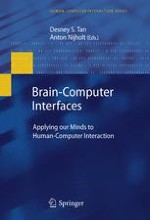2010 | OriginalPaper | Buchkapitel
10. Brain-Computer Interfacing and Games
verfasst von : Danny Plass-Oude Bos, Boris Reuderink, Bram van de Laar, Hayrettin Gürkök, Christian Mühl, Mannes Poel, Anton Nijholt, Dirk Heylen
Erschienen in: Brain-Computer Interfaces
Verlag: Springer London
Aktivieren Sie unsere intelligente Suche, um passende Fachinhalte oder Patente zu finden.
Wählen Sie Textabschnitte aus um mit Künstlicher Intelligenz passenden Patente zu finden. powered by
Markieren Sie Textabschnitte, um KI-gestützt weitere passende Inhalte zu finden. powered by
